虚树入门
1. 引
题目:BZOJ – 2286 消耗战
Description
在一场战争中,战场由 n 个岛屿和 n-1 个桥梁组成,保证每两个岛屿间有且仅有一条路径可达。现在,我军已经侦查到敌军的总部在编号为 1 的岛屿,而且他们已经没有足够多的能源维系战斗,我军胜利在望。已知在其他 k 个岛屿上有丰富能源,为了防止敌军获取能源,我军的任务是炸毁一些桥梁,使得敌军不能到达任何能源丰富的岛屿。由于不同桥梁的材质和结构不同,所以炸毁不同的桥梁有不同的代价,我军希望在满足目标的同时使得总代价最小。
侦查部门还发现,敌军有一台神秘机器。即使我军切断所有能源之后,他们也可以用那台机器。机器产生的效果不仅仅会修复所有我军炸毁的桥梁,而且会重新随机资源分布(但可以保证的是,资源不会分布到 1 号岛屿上)。不过侦查部门还发现了这台机器只能够使用 m 次,所以我们只需要把每次任务完成即可。
Input
第一行一个整数 n,代表岛屿数量。
接下来 n-1 行,每行三个整数 u,v,w,代表 u 号岛屿和 v 号岛屿由一条代价为 c 的桥梁直接相连,保证 1<=u,v<=n 且 1<=c<=100000。
第 n+1 行,一个整数 m,代表敌方机器能使用的次数。
接下来 m 行,每行一个整数 ki,代表第 i 次后,有 ki 个岛屿资源丰富,接下来 k 个整数 h1,h2,…hk,表示资源丰富岛屿的编号。
Output
输出有 m 行,分别代表每次任务的最小代价。
Sample Input
10
1 5 13
1 9 6
2 1 19
2 4 8
2 3 91
5 6 8
7 5 4
7 8 31
10 7 9
3
2 10 6
4 5 7 8 3
3 9 4 6
Sample Output
12
32
22
HINT
对于100% 的数据,2<=n<=250000,m>=1,sigma(ki)<=500000,1<=ki<=n-1
Source
2. 虚树 Virtual Tree
Nia,你在搞虚树啊?!虚树是个好东西! —— Cai
对于上面那题,我们不难发现——如果树的点数很少,那么我们可以直接跑 Dp。
首先我们称某次询问中被选中的点为——“关键点”
设 $Dp[i]$表示——使 $i$不与其子树中任意一个关键点联通的最小代价。
设 $w[a,b]$表示 $a$与 $b$之间的边的权值
则:
- 若 $son[i]$不是关键点:$Dp[i]=Dp[i] + min\{Dp[son[i]],w[i,son[i]]\}$
- 若 $son[i]$是关键点:$Dp[i]=Dp[i] + w[i,son[i]]$
很好,这样我们得到了一份 $O(n\times q)$的代码
听起来很有意思
我们不难发现——其实很多点是没有用的。
比如下图:
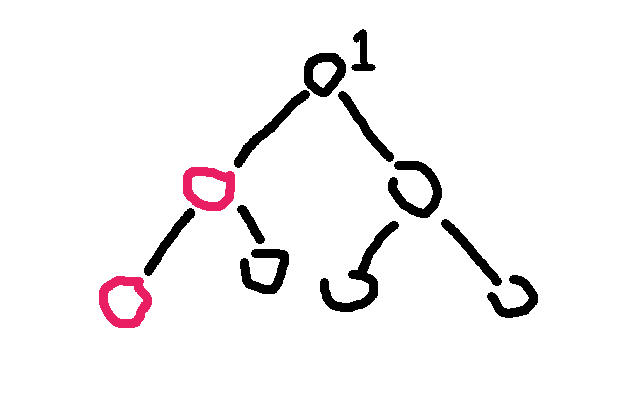
图中只有两个红色的点是关键点,而别的黑色的点全都是 “非关键点”。一号节点(敌人所在之处)是树顶的那个标了 1 的节点。
对于这题来说,我们只需要保证红色的点无法到达 1 号节点就行了。
通过肉眼观察可以得出结论——1 号节点的右子树(虽然实际上可能有多个子树,但这里只有两个子树,所以暂时这么称呼了)一个红色节点都木有,所以没必要去 Dp 它,不是吗?
观察题目给出的条件,红色点(关键点)的总数是与 $n$同阶的,也就是说实际上一次询问中红色的点对于整棵树来说是很稀疏的,所以如果我们能让复杂度由红色点的总数来决定就好了。
因此我们需要浓缩信息,把一整颗大树浓缩成一颗小树。
由此我们引出了 “虚树”这个概念。
我们先直观地来看看虚树的样子。
下图中,左边为原树,右边为生成的新的虚树。




看明白了吗?
因为任意两个关键点的 LCA 也是需要保存重要信息的,所以我们需要保存它们的 LCA,也就是虚树中不一定只有关键点
不难发现虚树中祖先->后代的关系并不会改变(就是不会出现原本 $a$是 $b$的祖先结果后面 $a$变成 $b$的后代了之类的鬼事)
但我们不可能 $O(k^2)$暴力枚举 LCA,所以我们不难想到——首先将关键点按 dfs 序排序,然后排完序以后相邻的两个关键点(相邻指的是在排序后的序列中下表差值的绝对值等于 1)求一下 $LCA$,并把它加入虚树。
因为可能多个节点的 $LCA$可能是同一个,所以我们不能多次将它加入虚树。
非常直观的一个方法是:
- 将关键点按 dfs 序排序
- for 一遍,任意两个相邻的关键点求一下 $LCA$,并且哈希表判重
- 然后根据原树中的祖先->后代关系建树(然而我并不知道怎么建树)
。。。
感觉很不可做的样子。<(=┘ ̄Д ̄)┘╧═╧
所以,这里我们提出一种用单调栈的做法。
在提出方案之前,我们先确认一个事实——在虚树里,只要保证祖先->后代的关系没有改变,就可以随意添加节点。
也就是,如果我们乐意,我们可以把原树中所有的点都加入虚树中,也不会导致 WA(虽然会导致 TLE)
因此,我们为了方便,可以首先将 $1$号节点加入虚树中,并且并不会影响答案。
好,开始讲怎么用单调栈来建立一颗虚树吧。
首先我们要明确一个目的——我们要用单调栈来维护一条虚树上的链。
也就是一个栈里相邻的两个节点在虚树上也是相邻的,而且栈是从底部到栈首单调递增的(指的是栈中节点 Dfs 序单调递增),说白了就是某个节点的父亲就是栈中它下面的那个节点。
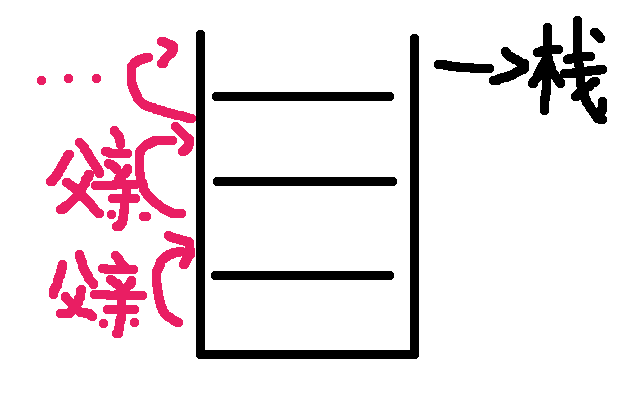
首先我们在栈中添加节点 $1$
然后接下来按照 Dfs 序从小到达添加关键节点。
假如当前的节点与栈顶节点的 $LCA$就是栈顶节点的话,则说明它们是在一条链上的。所以直接把当前节点入栈就行了。
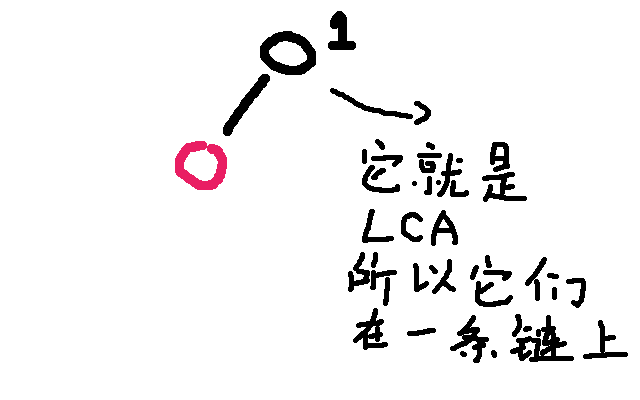
假如当前节点与栈顶节点的 $LCA$不是栈顶节点的话,比如这样——
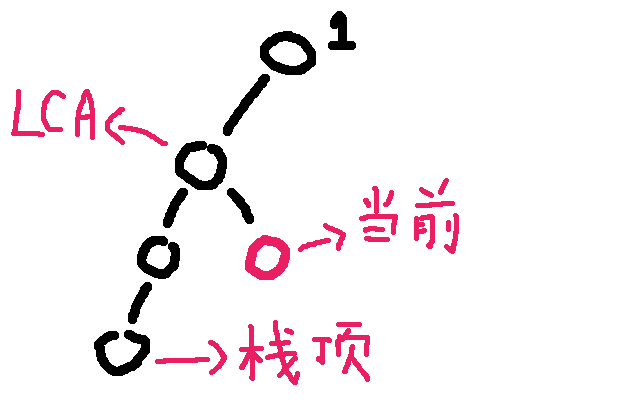
那就,,非常尴尬了
显然,当前单调栈维护的链是:
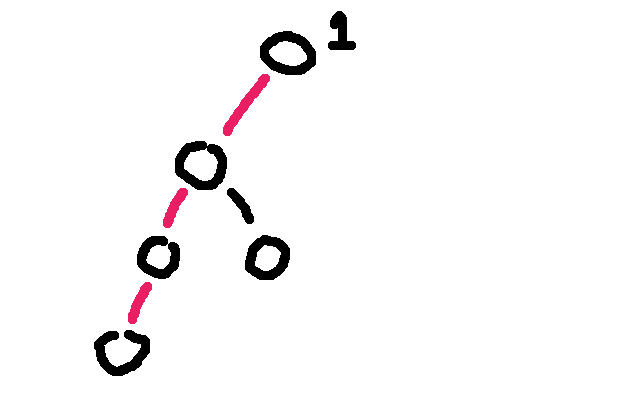
而我们需要把链变成:
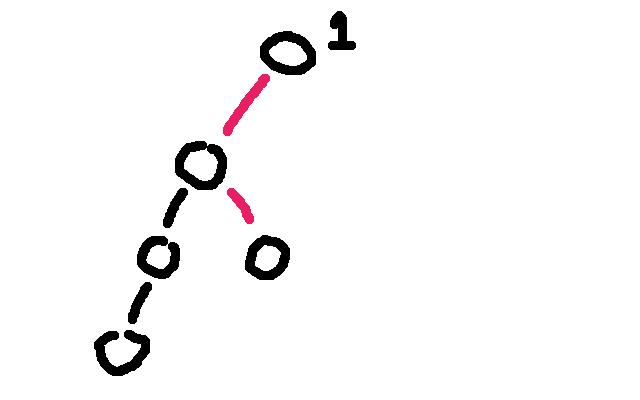
那么我们就虚树中连上这些边:
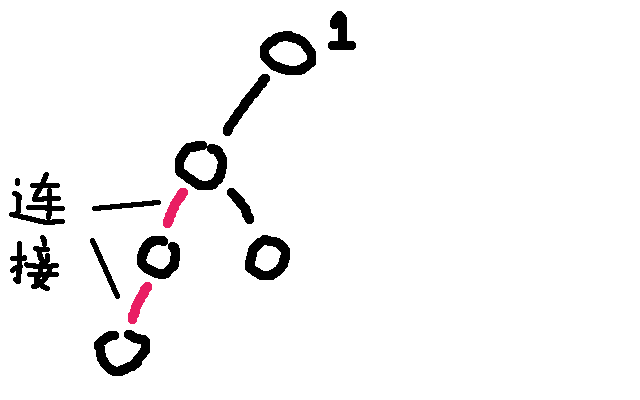
并且把这两个点从栈中弹出:
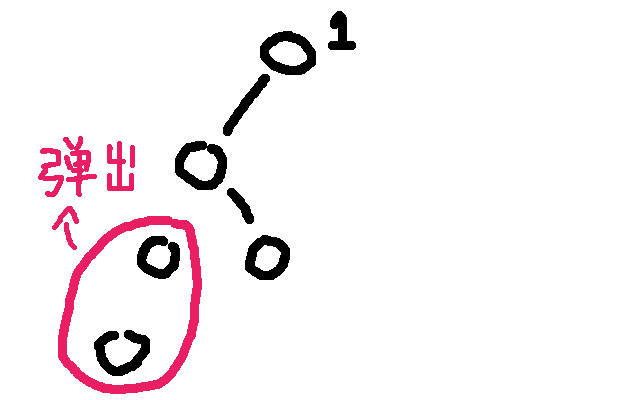
假如弹出以后发现栈首不是 $LCA$的话要让 $LCA$入栈。
再把当前节点入栈就行了。
打个比方吧。
假如那棵树长这样:
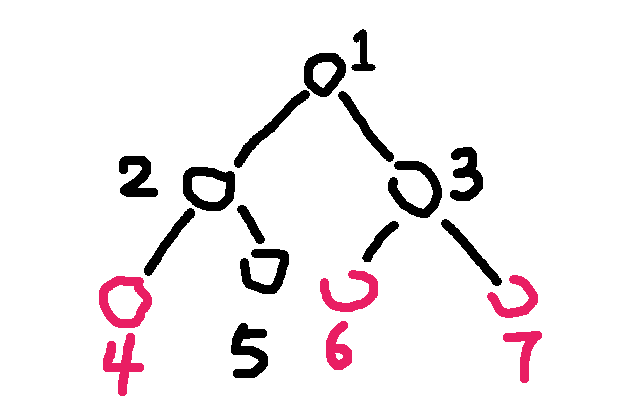
那么步骤是这样的:
- 将 3 个关键点 $6,4,7$(我故意打乱了)按照 dfs 序排序,得到序列 $4,6,7$
- 将点 $1$入栈
- 取序列第一个作为当前节点,为 $4$。再取栈顶元素,为 $1$。求 $1$和 $4$的 $LCA$:$LCA(1,4)=1$。
- 发现 $LCA(1,4)=$栈顶元素,说明它们在虚树的一条链上,所以直接把当前节点 $4$入栈,当前栈为 $4,1$
- 取序列第二个作为当前节点,为 $6$。再取栈顶元素,为 $4$。求 $6$和 $4$的 $LCA$:$LCA(6,4)=1$。
- 发现 $LCA(6,4)!=$栈顶元素,进入判断阶段。
- 判断阶段:发现栈顶节点 $4$的Dfs序是大于 $LCA(6,4)$的,但是次大节点(栈顶节点下面的那个节点)$1$的Dfs序是等于 $LCA$的(其实Dfs序相等说明节点也相等),说明 $LCA$已经入栈了,所以直接连接 $1->4$的边,也就是 $LCA$到栈顶元素的边。并把 $4$从栈中弹出。
- 结束了判断阶段,将 $6$入栈,当前栈为 $6,1$
- 取序列第三个作为当前节点,为 $7$。再取栈顶元素,为 $6$。求 $7$和 $6$的 $LCA$:$LCA(7,6)=3$。
- 发现 $LCA(7,6)!=$栈顶元素,进入判断阶段。
- 判断阶段:发现栈顶节点 $6$的Dfs序是大于 $LCA(7,6)$的,但是次大节点(栈顶节点下面的那个节点)$1$的Dfs序是小于 $LCA$的,说明 $LCA$还没有入过栈,所以直接连接 $3->6$的边,也就是 $LCA$到栈顶元素的边。把 $6$从栈中弹出,并且把 $LCA(6,7)$入栈。
- 结束了判断阶段,将 $7$入栈,当前栈为 $1,3,7$
- 发现序列里的 3 个节点已经全部加入过栈了,退出循环。
- 此时栈中还有3个节点:$1, 3,7$,很明显它们是一条链上的,所以直接链接:$1->3$和 $3->7$的边
- 虚树就建完啦!
其中有很多细节,比如我是用临接表存图的方式存虚树的,所以需要清空临接表。但是直接清空整个临接表是很慢的,所以我们在有一个从未入栈的元素入栈的时候清空该元素对应的临接表即可。
建立虚树的 C++代码大概长这样:
sort(h + 1, h + 1 + k, cmp);
sta[top = 1] = 1, g.sz = 0, g.head[1] = -1;
//1 号节点入栈,清空 1 号节点对应的临接表,设置临接表边数为 1
for (int i = 1, l; i <= k; i += 1) if (h[i] != 1)//如果 1 号节点是关键节点就不要重复添加
{
l = lca(h[i], sta[top]);//计算当前节点与栈顶节点的 LCA
if (l != sta[top])//如果 LCA 和栈顶元素不同,则说明当前节点不再当前栈所存的链上
{
while (id[l] < id[sta[top - 1]])//当次大节点的 Dfs 序大于 LCA 的 Dfs 序
g.push(sta[top - 1], sta[top]), top--;//把与当前节点所在的链不重合的链连接掉并且弹出
if (id[l] > id[sta[top - 1]])//如果 LCA 不等于次大节点(这里的大于其实和不等于没有区别)
g.head[l] = -1, g.push(l, sta[top]), sta[top] = l;
//说明 LCA 是第一次入栈,清空其临接表,连边后弹出栈顶元素,并将 LCA 入栈
else g.push(l, sta[top--]);//说明 LCA 就是次大节点,直接弹出栈顶元素
}
g.head[h[i]] = -1, sta[++top] = h[i];//当前节点必然是第一次入栈,清空临接表并入栈
}
for (int i = 1; i < top; i += 1) g.push(sta[i], sta[i + 1]);//剩余的最后一条链连接一下
于是我们就学会了虚树的建立了!
对于消耗战这题,直接在虚树上跑最开始讲的那个 $Dp$就行了,我们等于利用了虚树排除了那些没用的非关键节点!
- 若 $son[i]$不是关键点:$Dp[i]=Dp[i] + min{Dp[son[i]],w[i,son[i]]}$
- 若 $son[i]$是关键点:$Dp[i]=Dp[i] + w[i,son[i]]$
于是这题很简单就过了。
代码看下面。
推荐习题
BZOJ – 2286 消耗战
代码:
#include <bits/stdc++.h>
#define NS (250005)
#define LGS (18)
using namespace std;
typedef long long LL;
template <typename _Tp> inline void IN(_Tp& dig)
{
char c; bool flag = 0; dig = 0;
while (c = getchar(), !isdigit(c)) if (c == '-') flag = 1;
while (isdigit(c)) dig = dig * 10 + c - '0', c = getchar();
if (flag) dig = -dig;
}
struct graph
{
int head[NS], nxt[NS << 1], to[NS << 1], w[NS << 1], sz;
void init(){memset(head, -1, sizeof(head)), sz = 0;}
graph(){init();}
void push(int a, int b, int c)
{
nxt[sz] = head[a], to[sz] = b, w[sz] = c, head[a] = sz++;
}
int& operator [] (const int a){return to[a];}
}g;
int n, pre[NS][LGS + 1], dep[NS], mx[NS][LGS + 1], id[NS], dfn;
int m, k, h[NS], sta[NS], top, MX;
LL f[NS];
bool book[NS];
void Init(int a, int fa)
{
pre[a][0] = fa, dep[a] = dep[fa] + 1, id[a] = ++dfn;
for (int i = 1; i <= LGS; i += 1)
{
pre[a][i] = pre[pre[a][i - 1]][i - 1];
mx[a][i] = min(mx[a][i - 1], mx[pre[a][i - 1]][i - 1]);
}
for (int i = g.head[a]; ~i; i = g.nxt[i])
if (g[i] != fa) mx[g[i]][0] = g.w[i], Init(g[i], a);
}
int lca(int a, int b)
{
MX = INT_MAX;
if (dep[a] > dep[b]) swap(a, b);
for (int i = LGS; i >= 0; i -= 1)
if (dep[pre[b][i]] >= dep[a])
MX = min(MX, mx[b][i]), b = pre[b][i];
if (a == b) return a;
for (int i = LGS; i >= 0; i -= 1)
if (pre[a][i] != pre[b][i])
{
MX = min(MX, min(mx[a][i], mx[b][i]));
a = pre[a][i], b = pre[b][i];
}
return pre[a][0];
}
bool cmp(int a, int b){return id[a] < id[b];}
void Dp(int a)
{
f[a] = 0;
for (int i = g.head[a]; ~i; i = g.nxt[i])
{
Dp(g[i]);
if (book[g[i]]) f[a] += g.w[i];
else f[a] += min((LL)g.w[i], f[g[i]]);
}
}
int main (int argc, char const* argv[])
{
IN(n);
for (int i = 1, a, b, c; i < n; i += 1)
IN(a), IN(b), IN(c), g.push(a, b, c), g.push(b, a, c);
Init(1, 0), IN(m);
while (m--)
{
IN(k);
for (int i = 1; i <= k; i += 1) IN(h[i]), book[h[i]] = 1;
sort(h + 1, h + 1 + k, cmp);
sta[top = 1] = 1, g.sz = 0, g.head[1] = -1;
for (int i = 1, l; i <= k; i += 1) if (h[i] != 1)
{
l = lca(sta[top], h[i]);
if (l != sta[top])
{
while (id[l] < id[sta[top - 1]])
{
lca(sta[top - 1], sta[top]);
g.push(sta[top - 1], sta[top], MX);
top--;
}
if (id[l] > id[sta[top - 1]])
{
g.head[l] = -1 ,lca(l, sta[top]);
g.push(l, sta[top], MX), sta[top] = l;
}
else lca(l, sta[top]), g.push(l, sta[top--], MX);
}
g.head[h[i]] = -1, sta[++top] = h[i];
}
for (int i = 1; i < top; i += 1)
lca(sta[i], sta[i + 1]), g.push(sta[i], sta[i + 1], MX);
Dp(1), printf("%lld\n", f[1]);
for (int i = 1; i <= k; i += 1) book[h[i]] = 0;
}
return 0;
}
BZOJ – 3611 大工程
代码:
#include <bits/stdc++.h>
#define NS (1000005)
#define LGS (20)
#define INF (100000000)
using namespace std;
typedef long long LL;
template <typename _Tp> inline void IN(_Tp& dig)
{
char c; bool flag = 0; dig = 0;
while (c = getchar(), !isdigit(c)) if (c == '-') flag = 1;
while (isdigit(c)) dig = dig * 10 + c - '0', c = getchar();
if (flag) dig = -dig;
}
struct graph
{
int head[NS], nxt[NS << 1], to[NS << 1], sz;
void init(){memset(head, -1, sizeof(head)), sz = 0;}
graph(){init();}
void push(int a, int b)
{
nxt[sz] = head[a], to[sz] = b, head[a] = sz++;
}
int operator [] (const int a){return to[a];}
}g;
int n, id[NS], dfn, q, k, h[NS], sz[NS], mn[NS], mx[NS], mnans, mxans;
int pre[NS][LGS + 1], dep[NS];
int sta[NS], top;
bool book[NS];
LL f[NS], tot;
void Init(int a, int fa)
{
pre[a][0] = fa, dep[a] = dep[fa] + 1, id[a] = ++dfn;
for (int i = 1; i <= LGS; i += 1)
pre[a][i] = pre[pre[a][i - 1]][i - 1];
for (int i = g.head[a]; ~i; i = g.nxt[i])
if (g[i] != fa) Init(g[i], a);
}
int lca(int a, int b)
{
if (dep[a] > dep[b]) swap(a,b);
for (int i = LGS; i >= 0; i -= 1)
if (dep[pre[b][i]] >= dep[a])
b = pre[b][i];
if (a == b) return a;
for (int i = LGS; i >= 0; i -= 1)
if (pre[a][i] != pre[b][i])
a = pre[a][i], b = pre[b][i];
return pre[a][0];
}
bool cmp(int a, int b){return id[a] < id[b];}
void Dp(int a)
{
sz[a] = book[a], f[a] = 0;
if (book[a]) mn[a] = mx[a] = 0;
else mn[a] = INF, mx[a] = -INF;
for (int i = g.head[a], l; ~i; i = g.nxt[i])
{
Dp(g[i]), l = dep[g[i]] - dep[a];
tot += (f[a] + sz[a] * l) * sz[g[i]] + f[g[i]] * sz[a];
sz[a] += sz[g[i]], f[a] += f[g[i]] + l * sz[g[i]];
mnans = min(mnans, mn[a] + mn[g[i]] + l);
mxans = max(mxans, mx[a] + mx[g[i]] + l);
mn[a] = min(mn[a], mn[g[i]] + l);
mx[a] = max(mx[a], mx[g[i]] + l);
}
}
int main (int argc, char const* argv[])
{
IN(n);
for (int i = 1, a, b; i < n; i += 1)
IN(a), IN(b), g.push(a, b), g.push(b, a);
Init(1, 0), IN(q);
while (q--)
{
IN(k);
for (int i = 1; i <= k; i += 1) IN(h[i]), book[h[i]] = 1;
sort(h + 1, h + 1 + k, cmp);
sta[top = 1] = 1, g.sz = 0, g.head[1] = -1;
for (int i = 1, l; i <= k; i += 1) if (h[i] != 1)
{
l = lca(h[i], sta[top]);
if (l != sta[top])
{
while (id[l] < id[sta[top - 1]])
g.push(sta[top - 1], sta[top]), top--;
if (id[l] > id[sta[top - 1]])
g.head[l] = -1, g.push(l, sta[top]), sta[top] = l;
else g.push(l, sta[top--]);
}
g.head[h[i]] = -1, sta[++top] = h[i];
}
for (int i = 1; i < top; i += 1) g.push(sta[i], sta[i + 1]);
mnans = INF, mxans = -INF, tot = 0, Dp(1);
printf("%lld %d %d\n", tot, mnans, mxans);
for (int i = 1; i <= k; i += 1) book[h[i]] = 0;
}
return 0;
}
CF613D Kingdom and its Cities
代码:
#include <bits/stdc++.h>
#define NS (100005)
#define LGS (17)
using namespace std;
template <typename _Tp> inline void IN(_Tp& dig)
{
char c; bool flag = 0; dig = 0;
while (c = getchar(), !isdigit(c)) if (c == '-') flag = 1;
while (isdigit(c)) dig = dig * 10 + c - '0', c = getchar();
if (flag) dig = -dig;
}
struct graph
{
int head[NS], nxt[NS << 1], to[NS << 1], sz;
void init(){memset(head, -1, sizeof(head)), sz = 0;}
graph(){init();}
void push(int a, int b)
{
nxt[sz] = head[a], to[sz] = b, head[a] = sz++;
}
int operator [] (const int a){return to[a];}
}g;
int n, id[NS], dfn, q, k, h[NS], c[NS];
int pre[NS][LGS + 1], dep[NS];
int sta[NS], top;
bool book[NS];
void Init(int a, int fa)
{
pre[a][0] = fa, dep[a] = dep[fa] + 1, id[a] = ++dfn;
for (int i = 1; i <= LGS; i += 1)
pre[a][i] = pre[pre[a][i - 1]][i - 1];
for (int i = g.head[a]; ~i; i = g.nxt[i])
if (g[i] != fa) Init(g[i], a);
}
int lca(int a, int b)
{
if (dep[a] > dep[b]) swap(a, b);
for (int i = LGS; i >= 0; i -= 1)
if (dep[pre[b][i]] >= dep[a])
b = pre[b][i];
if (a == b) return a;
for (int i = LGS; i >= 0; i -= 1)
if (pre[a][i] != pre[b][i])
a = pre[a][i], b = pre[b][i];
return pre[a][0];
}
bool cmp(int a, int b){return id[a] < id[b];}
int Dp(int a)
{
int tot = 0, ans = 0;
for (int i = g.head[a]; ~i; i = g.nxt[i]) ans += Dp(g[i]), tot += c[g[i]];
if (book[a]) c[a] = 1, ans += tot;
else if (tot > 1) c[a] = 0, ans++;
else c[a] = tot;
return ans;
}
int main (int argc, char const* argv[])
{
IN(n);
for (int i = 1, a, b; i < n; i += 1)
IN(a), IN(b), g.push(a, b), g.push(b, a);
Init(1, 0), IN(q);
while (q--)
{
IN(k);
for (int i = 1; i <= k; i += 1) IN(h[i]), book[h[i]] = 1;
for (int i = 1; i <= k; i += 1)
if (book[pre[h[i]][0]]) {puts("-1"); goto end;}
sort(h + 1, h + 1 + k, cmp);
sta[top = 1] = 1, g.sz = 0, g.head[1] = -1;
for (int i = 1, l; i <= k; i += 1) if (h[i] != 1)
{
l = lca(h[i], sta[top]);
if (l != sta[top])
{
while (id[l] < id[sta[top - 1]])
g.push(sta[top - 1], sta[top]), top--;
if (id[l] > id[sta[top - 1]])
g.head[l] = -1, g.push(l, sta[top]), sta[top] = l;
else g.push(l, sta[top--]);
}
g.head[h[i]] = -1, sta[++top] = h[i];
}
for (int i = 1; i < top; i += 1) g.push(sta[i], sta[i + 1]);
printf("%d\n", Dp(1));
end : for (int i = 1; i <= k; i += 1) book[h[i]] = 0;
}
return 0;
}
BZOJ – 3572 世界树
丧心病狂啊
代码:
#include <bits/stdc++.h>
#define NS (300005)
#define LGS (19)
#define FIR first
#define SEC second
using namespace std;
typedef pair<int,int> PII;
template <typename _Tp>inline void IN(_Tp& dig)
{
char c; bool flag = 0; dig = 0;
while (c = getchar(), !isdigit(c)) if (c == '-') flag = 1;
while (isdigit(c)) dig = dig * 10 + c - '0', c = getchar();
if (flag) dig = -dig;
}
struct graph
{
int head[NS], nxt[NS << 1], to[NS << 1], sz;
void init(){memset(head, -1, sizeof(head)), sz = 0;}
graph(){init();}
void push(int a, int b)
{
nxt[sz] = head[a], to[sz] = b, head[a] = sz++;
}
int operator [] (const int a){return to[a];}
}g;
int n, m, q, h[NS], arr[NS], ans[NS];
int pre[NS][LGS + 1], dep[NS], id[NS], dfn, sz[NS];
int st[NS], top;
bool book[NS];
PII mx[NS];
bool cmp(int a,int b)
{
return id[a] < id[b];
}
void Init(int a, int fa)
{
pre[a][0] = fa, dep[a] = dep[fa] + 1, id[a] = ++dfn, sz[a] = 1;
for (int i = 1; i <= LGS; i += 1) pre[a][i] = pre[pre[a][i - 1]][i - 1];
for (int i = g.head[a]; ~i; i = g.nxt[i])
if (g[i] != fa) Init(g[i], a), sz[a] += sz[g[i]];
}
int jump(int a, int k)
{
for (int i = 0; i <= LGS; i += 1)
if ((k >> i) & 1) a = pre[a][i];
return a;
}
int lca(int a, int b)
{
if (dep[a] > dep[b]) swap(a, b);
b = jump(b, dep[b] - dep[a]);
if (a == b) return a;
for (int i = LGS; i >= 0; i -= 1)
if (pre[a][i] != pre[b][i])
a = pre[a][i], b = pre[b][i];
return pre[a][0];
}
void dfs1(int a)
{
if (book[a]) mx[a] = PII(0, a);
else mx[a] = PII(1e8, 0);
for (int i = g.head[a]; ~i; i = g.nxt[i])
{
dfs1(g[i]);
PII tmp = mx[g[i]];
tmp.FIR = dep[mx[g[i]].SEC] - dep[a];
mx[a] = min(mx[a], tmp);
}
}
void dfs2(int a)
{
for (int i = g.head[a]; ~i; i = g.nxt[i])
{
PII tmp = mx[a];
tmp.FIR += dep[g[i]] - dep[a];
mx[g[i]] = min(mx[g[i]], tmp), dfs2(g[i]);
}
ans[mx[a].SEC] = max(ans[mx[a].SEC], sz[a]);
}
void dfs3(int a)
{
for (int i = g.head[a], x, y, dis, z; ~i; i = g.nxt[i])
{
if (x = mx[a].SEC, y = mx[g[i]].SEC, x != y)
{
dis = dep[x] + dep[y] - (dep[lca(x, y)] << 1);
z = jump(g[i], (dis >> 1) - mx[g[i]].FIR);
if (dis & 1) ans[x] -= sz[z];
else
{
if (z != a && z != g[i])
z = jump(g[i], (dis >> 1) - mx[g[i]].FIR - (x < y));
else if (z == a)
z = jump(g[i], (dis >> 1) - mx[g[i]].FIR - 1);
ans[x] -= sz[z];
}
if (g[i] != z) ans[y] += sz[z] - sz[g[i]];
}
dfs3(g[i]);
}
}
int main (int argc, char const* argv[])
{
IN(n);
for (int i = 1, a, b; i < n; i += 1)
IN(a), IN(b), g.push(a, b), g.push(b, a);
Init(1, 0), IN(q);
while (q--)
{
IN(m), g.sz = 0;
for (int i = 1; i <= m; i += 1)
IN(h[i]), book[h[i]] = 1, ans[arr[i] = h[i]] = 0;
sort(h + 1, h + 1 + m, cmp), st[top = 1] = 1, g.head[1] = -1;
for (int i = 1, l; i <= m; i += 1)
{
if (h[i] == 1) continue;
l = lca(st[top], h[i]);
if (l != st[top])
{
while (id[l] < id[st[top - 1]])
g.push(st[top - 1], st[top]), top--;
if (id[l] > id[st[top - 1]])
g.head[l] = -1, g.push(l, st[top]), st[top] = l;
else g.push(l, st[top--]);
}
g.head[h[i]] = -1, st[++top] = h[i];
}
for (int i = 1; i < top; i += 1) g.push(st[i], st[i + 1]);
dfs1(1), dfs2(1), dfs3(1);
for (int i = 1; i <= m; i += 1) printf("%d ", ans[arr[i]]);
putchar(10);
for (int i = 1; i <= m; i += 1) book[h[i]] = 0;
}
return 0;
}
13 条评论
zhouzhendong · 2018年8月5日 6:32 下午
您好
您的虚树模板中
while (id[l] < id[sta[top - 1]])//当次大节点的 Dfs 序小于 LCA 的 Dfs 序
这句话的注释貌似应该把 “小于” 改成 “大于”
XZYQvQ · 2018年8月5日 8:44 下午
感谢提醒!已经更正!
您看得真仔细啊 OvO
感动.jpg
zhouzhendong · 2018年8月5日 8:45 下午
第一次学虚树,感谢大佬,写了这么好的博客
XZYQvQ · 2018年8月5日 8:48 下午
QAQ 我最弱了 QAQ
我写博客就是希望能帮助到大家,让大家躲开我学的时候踩过的坑 OvO
所以确实写的挺好的(逃OvO 话说呀:
zhouzhendong · 2018年8月5日 8:49 下午
友联之前加过了……
XZYQvQ · 2018年8月5日 8:51 下午
……
哈哈哈哈哈哈哈哈哈哈哈哈真是监介死了 QAQ
好吧是我煞笔 OvO
居然居然忘记了 OvO
比较健忘+疯狂扩列引发的惨案 OvO
抱歉抱歉 Orz
zhouzhendong · 2018年8月5日 8:52 下午
没事 OvO
zhouzhendong · 2018年8月5日 8:50 下午
怎么发现您的博客??
我有个同学冒用我的名字在您这里留言。
然后我的邮箱收到了您的回复邮件,然后就发现了。
Tmotf · 2018年5月13日 9:36 下午
上面那一个模拟虚树的过程最后 7,6, 1 不是位于一条链上啊,是不是有问题
XZYQvQ · 2018年5月14日 1:59 上午
谢谢提醒!已经改正啦!
litble · 2018年3月3日 11:15 上午
终于找到一篇能看的虚树入门了(泪流满面
网上那些 blog 的入门题总是直接上好难好难的题啊……
决定跟随 dalao 的脚步学虚树了 orz
foreverpiano · 2018年3月2日 11:50 下午
快来做 WC2018T1
konnyakuxzy · 2018年3月3日 8:35 上午
Orz
我太弱了
WC 根本没资格去
我还是滚了吧